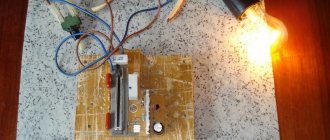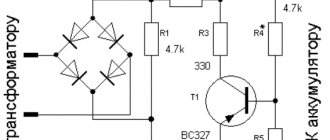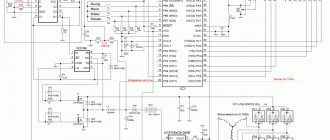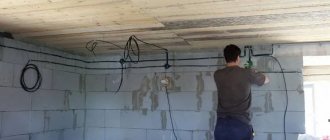Power control is required in various technological processes, mainly to maintain a given temperature using electric heaters or furnaces.
Thyristor circuits became widespread back in the 70s of the last century due to their reliability and high efficiency. These qualities, combined with a low price, make the thyristor current regulator the optimal solution for control tasks in modern industrial automation systems.
A thyristor regulator (hereinafter referred to as TR) is capable of regulating the power in the load using two methods:
1) phase method , in which each half-cycle of the mains voltage the power thyristors are unlocked with a time delay T3. The shape of the output voltage is illustrated in Figure 1. The area corresponding to the presence of voltage at the load is shaded in gray. The longer the unlocking time delay T3, the lower the output voltage.
Figure 1. Phase control method
Advantages of the method:
- continuity of regulation allows you to maintain the temperature of the object with high accuracy, which is especially important for control objects with low thermal inertia, for which even minor interruptions in the voltage supply are unacceptable, since this leads to temperature fluctuations, leading to defects in the technological process;
- the ability to implement a soft start to eliminate large starting currents. This is a very important property, since a common case is reduced resistance of the heating element when cold. A classic example is an incandescent lamp, through which, at the moment of switching on, an inrush current flows 10 times more than the rated current, which leads to its premature wear. The use of a soft start by applying a reduced voltage and gradually increasing it as the resistance of the heating element increases greatly extends its service life.
Disadvantages of the method:
- introducing strong impulse noise into the network and radio airwaves. Interference is created by switching surges that occur when switching thyristors and an abrupt increase in current in the load. Interference may affect the operation of sensitive electronic equipment;
- introducing nonlinear distortions into the network. The current shape when controlled by the phase method is often called a “chopped sine wave”. In addition to the fundamental harmonic, the current curve contains higher harmonic components that cause distortion in the voltage curve. In some cases, the distortion is so strong that the shape of the mains voltage only vaguely resembles a sine wave;
- consumption of reactive current from the network even with a purely resistive load and, as a consequence, a decrease in the power factor of the network.
Impulse noise and nonlinear distortion can be minimized by additionally installing network filters. As a rule, such filters consist of two parts: an inductive one, which smoothes the current curve, and a capacitive one, which suppresses high-frequency interference. Depending on the requirements for reducing the level of interference and nonlinear distortion, the cost of network filters can vary widely: from 20% to 100% or more of the cost of the thyristor regulator itself. However, quite often line filters are not installed at all, since, firstly, many loads have an inductive component (for example, when powering heaters through an isolation transformer), and secondly, distortion and interference are partially suppressed by the network’s own inductance. The inductive reactance of the network is determined by the inductance of the secondary winding of the transformer substation, the own inductance of wires and cables and the inductance of the phase-zero loop.
2) method of skipping the number of periods , in which the thyristors are turned on and off for a certain integer number of periods (Fig. 2). Other common names for this method are numerical or wave.
Figure 2. Method of regulation by skipping periods
Advantages of the method:
- No impulse noise is introduced into the network. Since the thyristors are turned on at the moment the mains voltage passes through zero, the current in the load increases smoothly, without causing electromagnetic interference.
- nonlinear distortions are not introduced into the network, since the load is powered by sinusoidal voltage;
- no reactive current consumption with a purely resistive load.
Disadvantages of the method:
- discrete regulation does not make it possible to maintain the temperature with high accuracy;
- not suitable for regulating light levels;
- Under certain conditions, subharmonics may appear in the network, that is, harmonics whose frequencies are lower than the network frequency.
Russian and foreign companies produce single- and three-phase modifications of thyristor regulators. A single-phase thyristor regulator can switch both phase and phase-to-phase network voltage to the load (see Fig. 3).
Figure 3. Connecting the load to a single-phase TR
The load to the output of the three-phase thyristor regulator is connected according to one of four circuits: “star” with a working zero (Fig. 4), “star” (Fig. 5), “triangle” (Fig. 6), open “triangle” (Fig. 7 ).
Figure 4. Connecting the load to the TP according to the “star” circuit with a working neutral Figure 5. Connecting the load to the TP according to the “star” circuit Figure 6. Connecting the load to the TS according to the “delta” circuit Figure 7. Connecting the load to the TS according to the open circuit “ triangle"
A common case is the so-called multi-zone regulation, when the load resistances are spatially separated and the problem arises of separate power control in each of the resistances. Options are possible here: either the use of several single-phase regulators, or the use of a thyristor regulator with the function of separate voltage regulation for each phase. Note that not all thyristor regulators support this function. Separate regulation is possible only when the load is connected according to a star circuit with a working neutral or an open delta circuit.
When connecting a load using a star or delta circuit, only joint phase control is possible, since in this case a change in the voltage at one of the load resistances leads to a change in the voltage at the other two resistances.
The control systems of modern thyristor regulators are based on microprocessor technology and provide the consumer with a wide range of service functions. Let's look at the most important of them.
Simple power regulator circuit
The very first devices whose task was to control and regulate power were based on Ohm's law. These are the simplest circuits that made it possible to regulate only one voltage source per device.
Ohm's law states that the power of electricity is directly equal to the square of the current. The device used was called a rheostat.
The rheostat can be connected either in series or obliquely, i.e. in the opposite direction. By changing the resistance, you can adjust the voltage power, everything is quite simple.
D) Monitoring the health of thyristors
The best models of thyristor voltage regulators diagnose the health of thyristors. This feature is very important not only because it allows you to detect a faulty device in time, but also because sometimes it prevents an even bigger accident. For example, if the load is connected through a transformer, then in the event of an internal break or short circuit of one of the thyristors, a voltage with a constant component is supplied to the transformer, and as a result, the magnetizing current of the transformer sharply increases, leading to intense heating and failure of the transformer. Therefore, a quickly detected malfunction of the thyristor regulator can prevent damage to expensive equipment.
Features of the rheostat
When current enters the rheostat, it begins to divide between the device and the load itself. If a sequential switching circuit is selected, then the voltage and current are monitored. When using a parallel connection circuit, the potential difference is controlled.
The rheostat itself can be completely different.
- Coal
- Liquid
- Metal
- Ceramic
When using a rheostat, you must remember the laws of physics. So the electricity that will be taken cannot simply evaporate. The rheostat will convert it into heat.
This must be taken into account in case you plan to supply large values to the device. In the case of a large load and heat generation, the need to remove excess heat must also be taken into account.
As a cooling system for the rheostat, you can use a blower or a container with oil in which the rheostat is placed. Both options have both advantages and disadvantages.
The rheostat is quite an interesting device; you can assemble a power regulator circuit with your own hands. However, it has one rather significant drawback: it is not possible to use a small device to pass large amounts of electricity through it.
Criteria for selecting a stabilizer for protecting household electrical appliances
Let's consider the main criteria for choosing a voltage stabilizer model to protect household loads.
| Selection criterion | Description |
| Phasing | As you know, only a single-phase stabilizer is applicable for a 220/230 V network. However, if a three-phase network is installed in the house, then you can use different options for organizing equipment protection, namely:
|
| output power | To prevent the stabilizer from overloading, its output power must be 20-30% greater than the total power consumption of the connected equipment. In this case, it is important to take into account the possible starting currents of a load that contains electric motors, for example, a refrigerator, washing machine or pump. Since when they occur, the power of such equipment can increase several times. Information about this load parameter can be found in the product data sheet. |
| Operating input voltage range | Each stabilizer model has its own operating voltage range. And if the network parameters go beyond its scope, the device will go into protection and turn off, de-energizing the load. Therefore, the product must be selected based on what voltage drops occur in the home electrical network. To do this, you need to take the appropriate measurements yourself or with the help of specialists. |
| Voltage correction accuracy | The error of the output voltage of the stabilizer must correspond to the requirements of the connected load. This parameter is also indicated in the product passport. As a rule, for most household appliances it is 5-7%, for lamps - 3%, and for high-precision equipment - up to 1%. |
| Output voltage form | For some types of loads, not only high accuracy of the output signal is important, but also its shape. A distorted sine wave can negatively affect the operation of equipment with electric motors, lighting systems, audio and video equipment, heating boilers with circulation pumps, etc. Such electrical appliances require only ideal sinusoidal voltage. |
| Types of electronic protection | The more electronic protections a stabilizer has, the better it is protected from problems in the electrical network and, accordingly, the more effectively it protects connected equipment from their negative effects. |
| Installation location | Depending on the size of the installation site and its purpose (residential or non-residential premises), the stabilizer is selected according to two parameters:
|
| Additional functionality | Often stabilizers have additional functionality that can be useful to the user. For example, some models are equipped with the ability to organize remote control of their operation via the Internet, allow you to adjust the output voltage to suit the load requirements, or have additional connectors for conveniently connecting a group of equipment. |
Modern devices
With the development of semiconductor technology, it was possible to make a significant step from the rheostat to more technologically advanced equipment, which is devoid of the disadvantages of its predecessor. Today, it is possible to use radioelements with an efficiency of 80%, which is very high in comparison with the same rheostat.
The use of such elements makes it quite easy and simple to use modern devices on networks with a voltage of 220 V, which is very convenient. At the same time, modern devices do not require large and complex cooling systems, as was the case in the past.
With the invention of integrated circuits, it was actually possible to make the power control device as miniature as possible, and at the same time increase the value of the maximum voltage that it can pass through itself.
Model range of voltage stabilizers "Shtil"
The Russian manufacturer of power supply systems "Shtil" produces a wide range of inverter voltage stabilizers, including:
- single-phase wall and floor/rack mounted models with output power from 0.3 to 18 kW;
- three-phase floor/rack mounted devices with output power from 5.4 to 16 kW;
- models with a 3 in 1 configuration (three phases into one) floor-standing/rack-mount design with an output power from 5.4 to 16 kW.
All devices operate on the basis of double energy conversion, thereby achieving:
- instant response to any mains voltage deviations;
- stabilization of the input signal with high accuracy (±2%) and in an extended range (from 90 to 310 V);
- power supply to the load with ideal sinusoidal voltage;
- uninterruptible power supply to equipment during short-term network outages (up to 0.2 s).
In addition, these models have electronic protection against overload, overheating, short circuit, network accidents and failures during operation. The devices are equipped with filters that protect against high-frequency interference and a varistor that neutralizes surge voltages.
Shtil inverter stabilizers have a silent (convection) or low-noise (convection/fan or fan) cooling system, which allows them to be used in residential areas.
Depending on the model, the devices have functionality that greatly simplifies their operation, making it as convenient as possible, for example, the possibility of remote monitoring via a smartphone, manual adjustment of the output voltage value, various connectors for simultaneous connection of the load, an informative LCD display that displays all the necessary power system parameters.
Varieties
Instructions on how to make a power regulator will depend on the specific type of this device chosen. Let's look at what types of devices there are today.
- Phase. One of the most common, used in lamps. Its task is to control the brightness of incandescent or halogen lamps.
- A triac power regulator is a device that regulates power by changing the number of voltage half-cycles, which are the ones that affect the load.
- Tristor. They are not very popular, but in some cases they can become an indispensable thing. The operating principle is based on a certain delay in turning on the tristor switch in the system during the half-cycle of the current.
Travel regulator. One of the most high-tech. Allows you to smoothly change voltage levels, reducing or increasing the electrical power that is supplied to the electric motor or elsewhere.
What is a voltage regulator and what are its types?
The term “voltage regulator” has a very broad interpretation, but in everyday life it is often understood as an electrical device such as a voltage stabilizer, which serves to correct the input voltage and bring its value to the nominal value - 220/230 V in single-phase and 380/400 V in three-phase electrical networks.
In addition to adjusting the input voltage, depending on the model, the stabilizer is able to protect the connected load from high-frequency interference, surge voltages, short circuits and network accidents.
Today, several types of such devices are used in the household sector, namely: relay, electromechanical, electronic and inverter models. Each product has a specific operating principle and its own technical features.
Transformer based voltage regulators
Relay, electromechanical, and electronic devices are based on transformer stabilization technology.
Their operating circuit includes an autotransformer, a switching device (relay, servo drive or semiconductor switches) and a control board. When network parameters change, these stabilizers automatically move their switching element to the required section of the transformer winding, due to which the load is supplied with an output voltage with a value as close as possible to the rated one. The more turns the transformer has, the more accurate the output voltage will be.
However, due to this operating scheme, transformer stabilizers have the following limitations: they are not capable of correcting network distortions, often have a slow response speed to network changes (for electromechanical models it can reach up to 100 ms), low stabilization accuracy and a narrow voltage range in which they can function (on average it is 130-270 V). In this regard, such devices cannot be used in the following cases:
- if frequent and significant voltage drops occur in the electrical network;
- if there is a load whose operation is highly dependent on the quality of the electrical network, for example, a heating system, computer equipment, a refrigerator.
Inverter based voltage regulators
Inverter stabilizers are based on transformerless double conversion technology. They do not contain a transformer or any switching elements, but instead a rectifier, a capacitor, an inverter and a microprocessor are installed.
The principle of operation of inverter models is that unstable mains voltage is supplied to the rectifier and transformed into direct voltage, then it accumulates in a capacitor and is converted back to alternating voltage using the inverter. Due to double conversion, the output voltage acquires reference technical characteristics, completely independent of their value in the input network. Thanks to the energy accumulated in the capacitor, these devices are able to instantly stabilize even the most sudden and significant network changes, as well as protect the load from short-term power outages in the network (up to 200 ms). Inverter stabilizers have the largest voltage range in which they can operate (90-310 V). At the same time, they always supply a signal of high accuracy and an ideal sinusoidal shape to the load.
These products effectively protect any electrically sensitive equipment and are suitable for work in suburban and rural networks, where problems with voltage surges are most common.
Adjustment
It is worth understanding that the adjustment of the device does not depend on the shape of the input signal. Based on the type of placement, devices are divided into stationary and mobile.
- The differences are obvious, the first type is securely attached to a specific place.
- The second option, on the contrary, has the ability to be in any place where it is convenient for the master.
The voltage regulation device is currently an electrical circuit, thanks to which it becomes possible to regulate the voltage in a particular building if everything is connected correctly.
Where to buy voltage regulators?
You can buy a high-quality inverter voltage regulator for household electrical appliances in our official online store or on the websites of our partners.
Our online resource has complete information on each stabilizer model, including a description of technical characteristics, operating features, additional functionality and areas of application. Each product card contains real user reviews about the operation of the equipment.
Both individuals and legal entities can order products. When placing an order, you can choose a convenient payment method or apply for a loan. Both pick-up and fast courier delivery to any city in Russia with the help of leading transport companies are available for selection.
If there is not enough information to select equipment, you can seek advice from our company’s specialists via online chat, email or phone.
Recommendations
If you do not have experience and knowledge of how to handle electrical appliances, then it is best not to touch them. If the wiring is incorrect, the network can receive a short circuit, as a result of which this device, as well as several others that were connected to the network, burned out.
Using the services of professionals significantly saves time and money, which you would still have to spend on a specialist if you did everything yourself. During the work, you can ask a professional about the manipulations being carried out.
He will tell you in detail what and how to connect and connect. Will share tips and tricks, conduct a practical lesson with devices.
B) Overheat protection
If the thyristor regulator is installed in a poorly ventilated place, during prolonged overload or if it is difficult to remove the generated heat (for example, when the blower fans fail), the cooling radiator can heat up to a high temperature of 90..100 C. A further increase in temperature can lead to the thyristors leaving the building and even fire. To prevent this, a temperature sensor is installed on the radiator, based on a signal from which the control system de-energizes the load.
Photo of a homemade power regulator
Share with friends
Safety and reliability of control
Almost all thyristor power controllers that you can order from our company are equipped with built-in fast fuses, which has a positive effect on reliability and safety. Despite their undeniable advantages, fuses have a significant drawback - disposability. After the protection has been activated, it is necessary to open the regulator housing to manually change the fuses. This disadvantage is compensated by the “electronic current limiter” option. Electronic current limitation is a reusable automatic protection with the highest possible performance, and the programming mode allows you to set the response threshold at any level. In this case, the electronic limiter does not replace, but complements the fuses. Also, the reliability and safety of operation not only of the regulator itself, but also of the entire technological process are increased by emergency detectors that will promptly notify of a short circuit, phase loss, exceeding the permissible temperature or exceeding the permissible current.
Power control methods
When describing the operation of a power regulator, it is impossible not to pay attention to such an important parameter as the control method (switching mode of power thyristors). You can buy a thyristor power regulator with the following main control modes: pulse number, packet switching, packet switching with soft start, phase switching, phase switching with soft start. Each method has its pros and cons, so the choice of mode is important and is selected individually, taking into account the characteristics of the production process. Switching modes are discussed in more detail in the article “Methods of regulation”, and our specialists will always be happy to help you.











